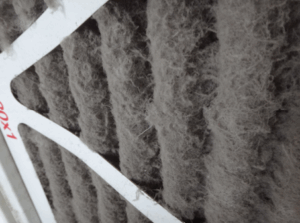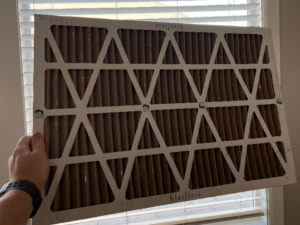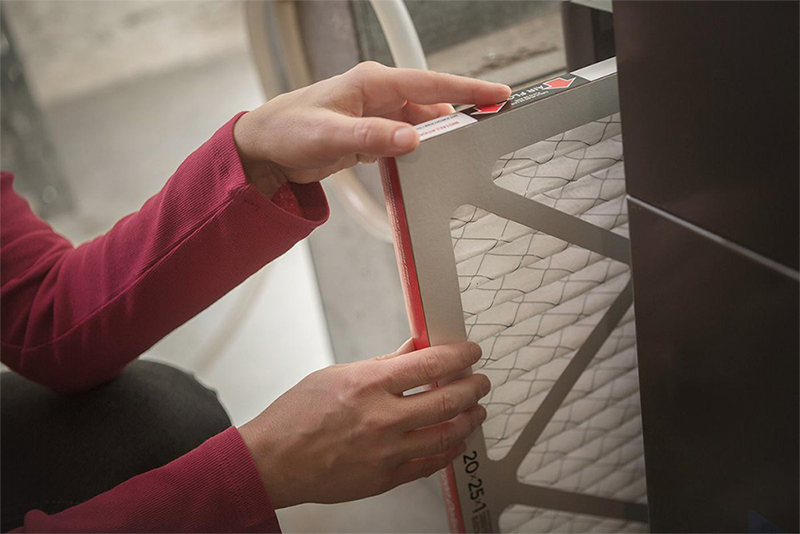When was the last time you checked your furnace filter? If you’re drawing a blank, you’re not alone. Many homeowners in Magic Valley only think about their filter when the furnace kicks on and the air feels dusty—or when allergy symptoms flare up indoors. But with October’s cooler nights settling in, now is the ideal time to swap it out. A clean filter makes a noticeable difference: fresher air, a system that runs more efficiently, and utility bills that are less likely to rise sky-high.
Use this guide to learn why filters and regular filter changes matter, the different types of filters available, and how to choose the best filter for your home.
Why Your Furnace Filter Matters
Your furnace filter is typically a shared filter for your HVAC system. It has a simple but critical job: to trap dust, pollen, pet dander, smoke, and other particles before they recirculate through your home. In Magic Valley, where wildfire smoke and heavy seasonal dust are common, that’s a big responsibility.
A clean filter:
- Helps your furnace or heat pump move air with less effort.
- Keeps your family breathing easier.
- Prevents extra strain that shortens the life of your system.
- Helps control energy costs, especially when heaters run daily.
Keeping your filter clean is a small step that makes a big difference for comfort, health, and your home’s efficiency all season long.
What Happens When Filters Get Dirty

Think of the filter as the gatekeeper of your home’s air. When it’s clogged, air has a harder time passing through. Your furnace works longer and harder, driving up energy use while particles sneak past and settle around your home.
That buildup has ripple effects:
- Rooms can feel stuffy or unevenly heated.
- Utility bills inch upward as the system uses more energy.
- Key components wear out faster, making breakdowns more likely.
Replacing your filter regularly restores airflow, protects your equipment, and helps your indoor air feel cleaner—without the constant battle against dust.
The Role of Regular Replacement
Changing the filter on schedule does more than improve comfort. It safeguards your system and your investment:
- Keeps airflow steady, so your furnace doesn’t overwork.
- Blocks allergens and irritants, which is especially important during cold months when homes are closed tight.
- Reduces buildup that can trigger expensive repairs.
- Extends the overall lifespan of your HVAC system.
The catch: not all air filters are the same. Picking the right kind of filter and filtration level—and replacing it at the right interval—is key.
MERV Ratings Explained
Filters are measured by MERV ratings (Minimum Efficiency Reporting Value). The higher the rating, the smaller the particles it captures. Most Magic Valley homes use filters between MERV 5–12. Here’s a quick breakdown:
- MERV 1–4: Basic dust and lint control. Low cost, but little benefit for allergies.
- MERV 5–8: Standard home option; captures dust, mold spores, and pet dander.
- MERV 9–12: Better filtration for families with allergies or asthma.
- MERV 13–16: “Hospital-grade” air filtration for homes/commercial use.
- HEPA Filters: “True” HEPA filters can rank around roughly a MERV 17-20 (which is beyond the MERV scale used in most residential HVAC systems). HEPA filters are usually incompatible with home HVAC systems. Always confirm compatibility with a technician before upgrading.
Common Filter Types
Different filters meet different needs:
- Fiberglass: Offers basic protection. They’re cheap and disposable.
- Pleated: Affordable, more effective at filtration, and available in higher MERV ratings.
- Washable: Reusable but requires routine cleaning and thorough drying to avoid mold.
- Electrostatic: Uses static charge to trap particles; available as washable or disposable.
- HEPA: HEPA filters trap 99.97% of fine particles, but their density can strain standard furnaces. They’re best for specialized HVAC systems or standalone purifiers.
Most Magic Valley families find pleated filters offer the best balance of performance and affordability.
How Often Should You Replace Your Filter?

The right replacement schedule depends on the filter type, your household, and local conditions. Use our guide, “How to Replace Your HVAC Filters,” to help you check and replace your filters correctly. For disposable or pleated filters, an easy way to check the filter is to hold it up to a light or a window. If no light passes through the filter, then it’s time to replace it.
A general rule of thumb:
- Fiberglass: 30 days
- Pleated: 60–90 days (30–45 if you have pets or allergies)
- Washable: clean monthly
- Electrostatic: 1–3 months
- HEPA: 6–12 months
Local tip: Magic Valley’s dust, farm activity, and wildfire smoke can clog filters faster than expected. It’s a good habit to check your filter once a month during fall and winter.
Simple Habits to Stay on Track
Try embedding these habits into your monthly routine to make sure you never miss a check:
- Check it with light: Lift the filter up to a light or window. If no light passes through the filter, then it’s time to replace it.
- Record the date: Each time you replace the filter, mark the replacement date on the filter’s edge.
- Build a routine: Align filter checks with the start of each month—or with your utility bill due date as a reminder.
These small steps prevent your system from working harder than it needs to and help keep your air healthy.
Pair It with a Professional Tune-Up
Changing the filter is step one, but for full peace of mind, schedule a professional furnace tune-up each fall. A trained technician will clean internal parts, check safety controls, and make sure your system is ready for Idaho’s long winter.
When you combine a clean filter with a professional tune-up, you can:
- Keep your system running efficiently and help lower energy costs.
- Spot small issues before they turn into costly repairs.
- Protect your family from hazards like carbon monoxide leaks.
A little preventative care goes a long way—help your furnace work smarter, stay safe, and keep your home cozy all winter long.
Ready for the Season Ahead
Staying on top of furnace filter replacement is one of the simplest, most effective ways to protect your home this fall. Clean filters mean cleaner air, a longer-lasting system, and lower energy bills. Pair that with a professional tune-up, and you’ll be ready for whatever Magic Valley weather brings this winter.
At Magic Electric, Plumbing, Heating + Air, our expert technicians help families across Magic Valley choose the right filter, replace it on schedule, and keep their systems tuned for comfort all season long. Call today or schedule online to book your fall furnace service and head into winter with confidence.

